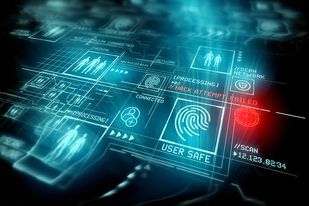Businesses can be best described as blockchain technology, a firm linked with their customers, vendors, and suppliers, acting as blocks in a chain of networks. Every alteration or adjustment in the structure of the business entity or financial institution affects the entire network.
The functional biometric solutions at the time of initial KYC/AML verification authenticate the originality of an individual by validating his/her personally identifiable information against data stockpiled in classified government directories and watchlists of federal/intelligence agencies, to make sure that the prospect is clean and risk-free that also helps further in risk management. AI-driven biometric solutions throughout, play a crucial role in the transaction monitoring of clients as well, protecting the interests of both organization and its customers
How Biometric Solutions Verify Identity of a Prospect?
Professional fraudsters and hackers are becoming increasingly sophisticated in their techniques to disguise and conceal the origins of the proceeds of their financial crimes. With the ever-increasing cases of money laundering and synthetic ID scams, firms and banks are therefore extremely cautious about AML/KYC protocols and standards.
- At the beginning of biometric identification, the individual provides documentation consisting of his facial data, comprised of a photo-based national ID card, driving license, passport, and other records, where the system performs an OCR check on the ID documents to extract and verify the textual data, in no time with great accuracy.
- Along with the records, the individual uploads a live selfie. The biometric solutions authenticate the person’s identity on the basis of facial traits. The textual data and images then are verified from restricted regulatory archives.
- The final results are generated seamlessly in no time and saved in the firm’s storage for ongoing monitoring and protection of assets and data of existing clients.
Characteristics of AI-based Biometric Solutions
For biometric identification, a 3D depth analysis is performed to ensure that there are no such uses of screenshots or older images and that the uploaded one is authentic
AI-Driven Mapping Tools
The faceprints in biometric solutions recognize characteristics like age, race, and gender, to ensure that information on ID documents corresponds with the facial features. This additional layer of protection of the biometric authentication process makes fraud prevention frictionless.
Micro Facial Expressions Analysis
The biometric technology performs depth checks and confirms the liveliness of the user by capturing minor expressions such as blinking or smiling.
Biometric Verification Vs Passwords/PINs
One of the prime reasons for account takeover is compromised or poor passwords. In this digital space, a regular individual owns different social accounts, ATM cards, email IDs, bank accounts. Formulating a complex password for each one is not practiced. Weak or the same passwords for different accounts increases risk which is instantly eliminated through biometric technology.
The facial data can’t be stolen like passwords or PINs. Therefore, biometric solutions are more preferred as they also reduce the sign-up times of platforms and speed up the transactions.
Use cases of Biometric Solutions
Transactional Verification
The biometric solutions have made the online banking and payments industry way more secure. The technology enables the customer to log in through selfie authentication, and all transactions being made are validated through biometric verification
Prior to the major transaction of funds, in biometric identification online, the consent of the customer is received in the form of a picture showcasing a note with the name of the customer along with the date of the transaction to avoid chargebacks.
Age Verification
Children’s Online Privacy Protection Act of 1998 clearly states that the eligible age for particular online games, materials, and consumption of substances such as alcohol and cigarettes is 13 and 18 respectively in most of the states. The automated biometric solutions enable age-specified businesses to verify the eligibility of customers through their ID credentials in moments.
Airport Clearance
The biometric solutions are massively used in airport screening of passengers, especially for surveillance of suspected leads who are in ECL or any watchlist.
For KYC/AML Verification
In banks and crypto exchanges, biometric solutions guarantee legitimate customer onboarding and the safety of sensitive information and funds of existing customers.
Conclusion
The constantly increasing cases of ID frauds, age verification scams, and financial crimes call for efficient biometric solutions. The machine learning algorithms of biometric solutions with AI-driven mapping tools perform microexpression analysis to avoid 3D mask attacks and spoofing to assess the authenticity of an individual in no time. It streamlines the customer onboarding procedure and biometric sign-in always validates the control of authorized 8isouls over payments/transactions. The biometric solutions reduce risk to zero for entities, so they can provide a better digital user experience to their customers.
